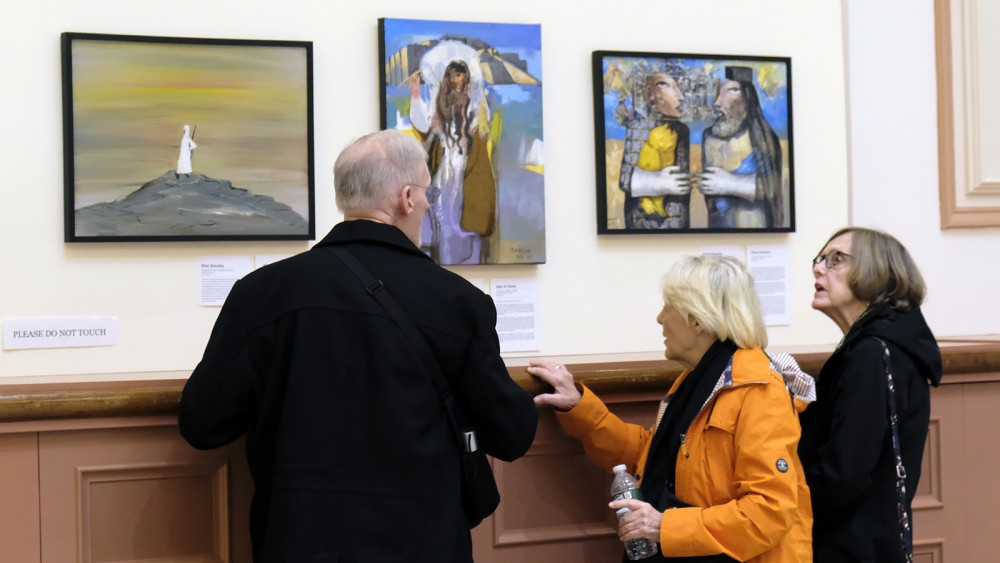With exhibit on Abraham, Episcopal cathedral in Boston organizes interfaith conversation

The day after the deadly mass shooting at Pittsburgh’s Tree of Life synagogue last October, more than a thousand people gathered on the Boston Common to mourn and pray.
As Amy McCreath, dean of the Cathedral Church of St. Paul, which overlooks America’s oldest park, watched people of various faiths unite to mourn another national tragedy, she was hit with an emotional realization.
“I looked out over the crowds of people, and it was so clear that all of them really want a peaceful future,” she remembered. “We want to work together against violence, but we don’t even know each other. Unfortunately, the odds are good that something like that will happen again, and we need to be prepared to support one another and defend one another.”
That’s part of the reason the Episcopal cathedral agreed to host a new interfaith art exhibit that explores the faith and life of Abraham, the shared spiritual forefather of the world’s three largest monotheistic religions, and launched an accompanying interfaith book study to spotlight Abraham’s wives, Sarah and Hagar.
Read our latest issue or browse back issues.
The two-year touring exhibition Abraham: Out of One, Many is curated by Paul-Gordon Chandler of Caravan, an international art nonprofit affiliated with the Episcopal Church. After premiering in Rome in May, the show began a 20-month US tour at Nebraska’s Tri-Faith Initiative this fall. In late October, St. Paul received the 15 paintings, which are arranged in sets of three to illustrate Abraham’s journey through the eyes of Middle Eastern artists from Muslim, Christian, and Jewish backgrounds.
Local Iraqi Muslim painter Sinan Hussein, California-based Chaldean artist Qais Al-Sindy, and Jewish Jerusalem-based painter Shai Azoulay each offer their own depictions of five themes within Abraham’s spiritual journey: Living as a Pilgrim, Welcoming the Stranger, Sacrificial Love, The Compassionate, and A Friend of God.
The exhibition is a response to a new wave of anti-Semitic and anti-Muslim hate, as well as the “general climate of growing prejudice and stereotyping” and “tribalism” that have enveloped the country, Chandler said.
“In these three faith traditions, whose followers are referred to as ‘children of Abraham,’ Abraham is seen as a model of hospitality—of welcoming the ‘stranger’ and embracing the ‘other,’” said Chandler, who was recently appointed rector of the Anglican Centre in Qatar. “The exhibition attempts to artistically answer the question, ‘What can Abraham teach us today about freeing our world from sectarian strife?’”
In Al-Sindy’s interpretation of welcoming the stranger, the artist reimagines the iconic image of three men visiting Abraham—sometimes interpreted as the three parts of the Christian Trinity—as representatives of the three Abrahamic faiths. Hussein depicts Abraham’s son Ishmael as the stranger, noting that outside of Islam’s telling of the story Ishmael is often sidelined as a character. (Hussein’s painting can be seen here.) Azoulay’s painting shows the continuous nature of Abraham’s welcome of the three strangers in the desert.
The book used by the study group is one edited by feminist biblical scholars Phyllis Trible and Letty Russell. It includes essays by three women scholars from each faith tradition. For each reading group session, a local woman scholar or faith leader of that tradition leads a discussion on a chapter of the book and what the figures of Sarah and Hagar mean for different communities.
The figure of Hagar, especially, has undergone a “sort of rediscovery”—as Jane Redmont, organizer of the study group, put it—among scholars and faith leaders over the past few decades. That trend is evident in Nyasha Junior’s new book Reimagining Hagar, Mohja Kahf’s 2016 anthology Hagar Poems, and a recent push among Muslim women scholars for imams to deliver Eid al-Adha sermons focused on Hagar’s sacrifices and strength, among other initiatives.
Redmont said many people are particularly unaware of Hagar’s prominence in Islam. For Muslims, Hagar is believed to be the mother of all Arab people and the matriarch from whom the Prophet Muhammad eventually descends. She figures prominently in hajj rituals, with many elements of the pilgrimage coming from stories of her efforts to survive in the wilderness outside Mecca with Ishmael. Many Muslims also believe she and Ishmael are buried at the Kaaba, which Abraham is believed to have built.
Both Sarah and Hagar, along with their children, Isaac and Ishmael, are often taken as symbols in the Israeli and Palestinian conflict, Redmont also noted, because they are seen as the ancestors of Jewish and Muslim people, respectively.
That modern context makes a “very live backdrop” for the exhibit and for the reading group, she said.
“We’re not going to solve these problems with an exhibit or a book group, and nobody’s under any illusion that we are,” she added. “But we have to start somewhere. And what art can do is it can open people’s hearts and put them in a contemplative space.” —Religion News Service






